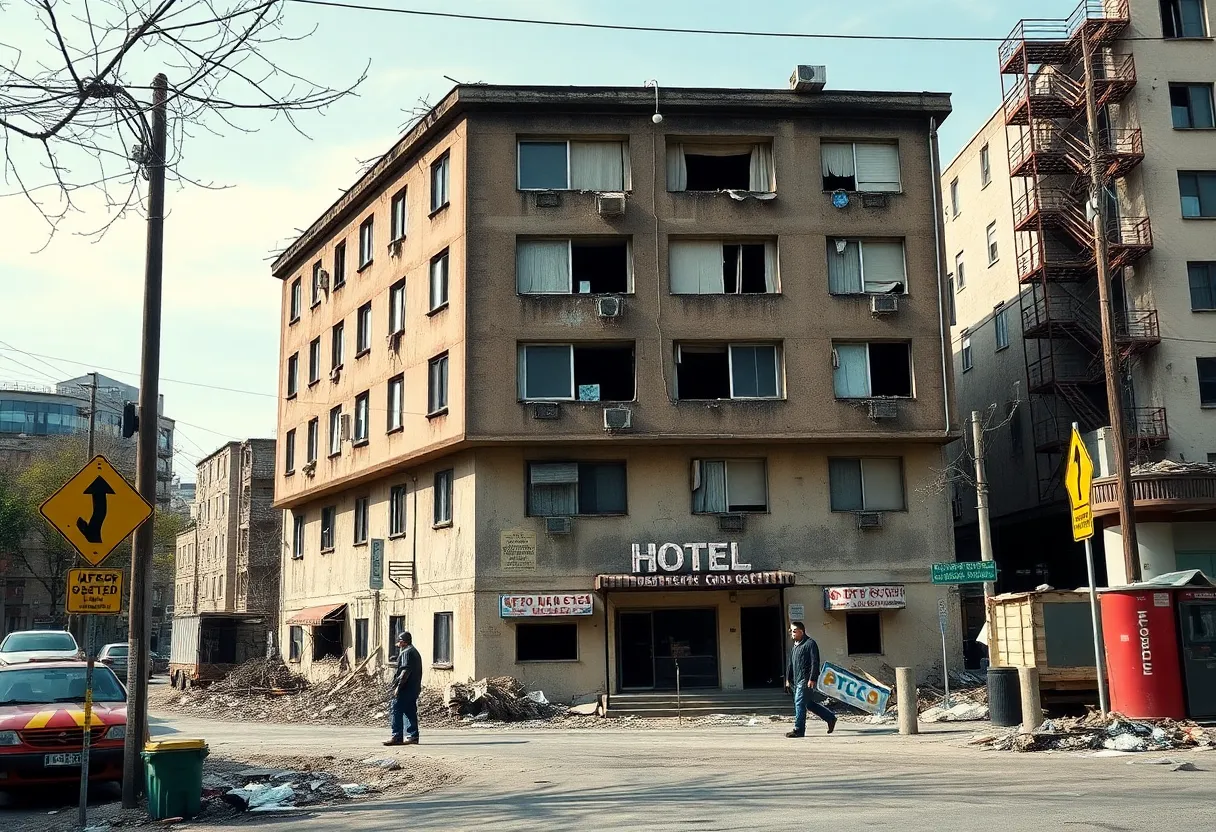Buffalo, NY, October 17, 2025
Buffalo city officials have begun eminent domain proceedings against the Buffalo Grand Hotel due to code violations and safety hazards threatening the Fruit Belt neighborhood. This decision follows attempts to compel the owners to rectify deteriorating conditions. City plans include either demolishing the property or redeveloping it to enhance community safety and vitality. Local residents view this action as a necessary step towards revitalization in an area suffering from urban decay.
Buffalo Initiates Eminent Domain to Seize Troubled Buffalo Grand Hotel Property
Buffalo, NY – In a decisive step to tackle urban decay, city officials have launched eminent domain proceedings against the Buffalo Grand Hotel property on Genesee Street. The action targets persistent code violations and safety hazards that have plagued the site, threatening the surrounding Fruit Belt neighborhood. This move signals the city’s determination to curb blight and restore safety in a historically significant area.
The proceedings come after repeated failed attempts to compel the property owners to address the deteriorating conditions. Officials cite structural instability, fire safety risks, and environmental hazards as primary concerns. Once the property transfers to municipal ownership, plans for either demolition or redevelopment will take shape, aiming to revitalize the block and prevent further decline.
Details of the Violations and Hazards
The Buffalo Grand Hotel, once a bustling fixture in the city’s hospitality scene, has fallen into severe disrepair over the years. Recent inspections revealed critical issues, including crumbling facades that pose risks to pedestrians and nearby structures. Interior assessments uncovered mold infestation, exposed wiring, and unstable flooring, all contributing to an unsafe environment. These problems have escalated to the point where the site is considered a public nuisance, violating multiple city building codes.
City enforcement teams have documented over a dozen violations in the past two years alone, ranging from unpermitted alterations to neglect of basic maintenance. The hazards extend beyond the building itself, with debris accumulation on the grounds attracting vermin and endangering public health. In the Fruit Belt, a neighborhood known for its residential charm and proximity to medical facilities, residents have long voiced concerns about the eyesore’s impact on property values and community well-being.
Next Steps in the Eminent Domain Process
Eminent domain allows the government to acquire private property for public use, provided fair compensation is offered to the owners. In this case, the city argues that the acquisition serves the greater good by eliminating blight and fostering economic growth. Legal notifications have been issued to the property holders, initiating a process that could involve court hearings if disputes arise over valuation or compliance.
Should the seizure succeed, the city plans to conduct a thorough environmental cleanup before deciding on the site’s future. Demolition would remove the hazardous structure entirely, clearing space for potential green initiatives or affordable housing. Redevelopment options might include mixed-use developments that align with Buffalo’s ongoing urban renewal efforts. Community input will play a role in shaping these plans, ensuring they meet local needs.
Broader Context of Blight in Buffalo
The Buffalo Grand Hotel case reflects a larger challenge in Buffalo, where aging infrastructure and absentee ownership have led to numerous blighted properties. The Fruit Belt, sandwiched between downtown and the city’s medical corridor, has been particularly vulnerable. This neighborhood, home to diverse families and historic row houses, has seen revitalization through recent investments in parks and transit. However, pockets of neglect, like the hotel site, undermine these gains.
Buffalo’s administration has ramped up anti-blight measures in recent years, deploying task forces to monitor at-risk buildings and offering incentives for responsible redevelopment. Similar eminent domain actions have succeeded in other parts of the city, transforming derelict sites into vibrant community assets. For instance, past projects have yielded new commercial spaces and housing units, boosting local economies.
The push against the Buffalo Grand Hotel underscores a commitment to proactive governance. By addressing safety hazards head-on, the city not only protects residents but also paves the way for sustainable growth. As the legal process unfolds, stakeholders will watch closely to see how this effort contributes to the ongoing transformation of Buffalo’s urban landscape.
The initiative highlights the balance between property rights and public interest. While owners may contest the seizure, the city’s focus remains on mitigating immediate risks and planning for long-term benefits. This approach aims to set a precedent for handling similar issues across the city, ensuring that no neighborhood is left behind in Buffalo’s resurgence.
Impact on the Fruit Belt Community
Local residents in the Fruit Belt have welcomed the news, viewing it as a victory against years of frustration. The neighborhood’s proximity to major hospitals makes safety paramount, as any incident at the site could disrupt essential services. Families have adapted to avoiding the area, but the constant reminder of decay has weighed on community morale.
With the property under city control, expectations are high for positive change. Potential redevelopment could introduce jobs, improved walkability, and enhanced aesthetics, aligning with broader goals for equitable development. Buffalo’s efforts in this vein continue to evolve, drawing on lessons from successful interventions elsewhere in the region.
In summary, the eminent domain action against the Buffalo Grand Hotel marks a critical juncture for the city. By prioritizing public safety and neighborhood vitality, officials are working to build a more resilient Buffalo, one property at a time.
FAQ
What action have Buffalo city officials taken regarding the Buffalo Grand Hotel?
City officials have initiated eminent domain proceedings against the Buffalo Grand Hotel property on Genesee Street.
Why are these proceedings being pursued?
The move addresses ongoing code violations and safety hazards at the property.
Which neighborhood is affected by this property’s condition?
The property’s issues threaten the Fruit Belt neighborhood.
What happens after the ownership transfers to the municipality?
Demolition or redevelopment plans will follow once ownership transfers to the municipality.
What are the main safety concerns mentioned?
Safety hazards include structural instability, fire risks, and environmental issues stemming from code violations.
Key Features of the Buffalo Grand Hotel Eminent Domain Case
| Feature | Description |
|---|---|
| Location | Genesee Street, Buffalo, NY |
| Property | Buffalo Grand Hotel |
| Legal Action | Eminent domain proceedings initiated by city officials |
| Reasons | Ongoing code violations and safety hazards |
| Affected Area | Fruit Belt neighborhood |
| Future Plans | Demolition or redevelopment after ownership transfer |
| Goal | Prevent further blight and ensure public safety |
Deeper Dive: News & Info About This Topic
HERE Resources
Buffalo’s Shea’s Performing Arts Center Announces $10 Million Expansion




